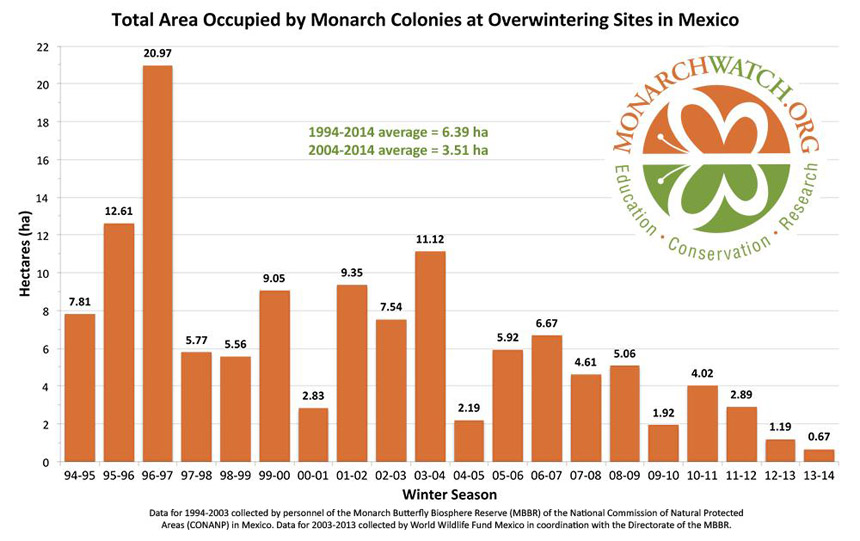The monarch butterfly is in serious danger of disappearing from North America?
This much beloved butterfly, voted the state butterfly of seven different states and the symbol of cooperation between Canada, the United States and Mexico is in deep trouble. The monarch lives during the summer months in the northeast part of the United States and the southeast parts of Canada, drinking nectar from flowers and reproducing. The generation that is born during the late summer will begin their spectacular migration to Mexico, a journey of up to 3,000 miles. This generation is called the Methuselah generation because they can live up to 8 months. The monarchs living in the spring and summer have a life span of about 4-5 weeks. The monarchs spend the winter in Mexico preserving their energy high up on mountains that they have been visiting for 1,000’s of years. However, the evolutionary history of the monarch migration remains largely unknown to science.
The population measured in Mexico this winter was the lowest on record. See the graph below.

There are three main reasons for the decline of the monarch population. The first is because of the adoption of herbicide tolerant crops, or GMO crops (genetically modified organisms). These are plants that have been genetically modified so that they can be sprayed with herbicides and it doesn’t kill the plant, but the herbicide does kill all of the weeds. This seems like it would be wonderful, except for the fact that monarchs need a plant called milkweed to lay their eggs on. They can’t lay eggs on any other plant. Their caterpillars eat milkweed for food when they hatch out of the egg. When the crops are sprayed with herbicide, it kills all of the milkweed that used to grow in the fields with the corn and the soybeans. It is estimated that we have lost up to 150 million acres of monarch breeding ground due to the planting of GMO crops. The second factor is the ethanol mandate from the Federal Government that was passed as the Clean Energy Bill in 2007. Since that time another 20 million acres of land have been cleared as farmers have anticipated the price of corn increasing. Many of those acres were hedgerows, native prairies, and CRP’s, Conservation Reserve Program land. This is land that the Government pays farmers a small fee to hold and not farm for conservation use. The final factor is development. Development consumes about a million acres of farmland a year. Another million acres of woodland and other types of land are lost to the endless shopping strips, suburbs and roads that are continually being built. This has added up to over 17 million lost acres since 1996.
This is a huge loss of breeding habitat for monarchs, and with such a low overwintering population, scientists are worried about what will happen this spring. It is clear that efforts must be made to plant milkweed across Mexico, the United States and Canada if we want to help bring back the monarch population.
How can you help?
- Plant a butterfly garden, include milkweed and native nectar plants
- Avoid the use of pesticides
- Report monarch observations
- Limit mowing in open fields, especially in late summer
For more information please visit: http://www.learner.org/jnorth/tm/monarch/conservation_action_resources.html
FREE MILKWEEDS FOR SCHOOLS AND NON-PROFITS
Monarchs and pollinators need our help due to habitat loss. If your school or non-profit organization is interested in this conservation measure, we can help you create a habitat for monarchs and pollinators. Please apply using the form below. If your organization qualifies, we will provide a free flat of 32 live milkweed plugs as well as guidance on how to create a new habitat or enhance an existing garden.The Natural Resources Defense Council (NRDC) has provided funds for this project.
Download an application for free milkweed.
http://monarchwatch.org/bring-back-the-monarchs/docs/free-milkweeds-application.doc
The application and supporting documents can be emailed directly to Angie Babbit at milkweed@monarchwatch.org.
